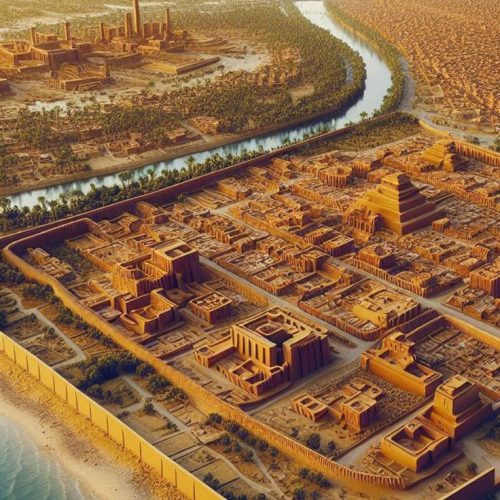Nestled in the arid landscape of Gujarat’s Kutch district lies Dholavira, one of the most captivating archaeological sites in India. This ancient city is one of the best-preserved urban settlements of the Indus Valley Civilization, dating back nearly 5,000 years. Known for its advanced water management systems, unique architecture, and impressive fortifications.
What Makes Dholavira Special?
Dholavira is one of the five largest Harappan sites and one of the most significant excavations of the Indus Valley Civilization. What sets Dholavira apart from other sites, such as Harappa and Mohenjo-Daro in present-day Pakistan, is primarily its incredible state of preservation. In contrast to these other sites, Dholavira has remained exceptionally well-preserved, offering unique insights into ancient urban planning and culture.
Discovered in 1967 by archaeologist Jagat Pati Joshi, the site provides a glimpse into the sophisticated urban planning, engineering skills, and social structure of the Indus Valley people.
Historical Significance of Dholavira
The city of Dholavira flourished around 3000 BCE to 1500 BCE, during which time the Indus Valley Civilization was at its height. It’s believed to have served as a major trade and commercial center, linking ancient cultures and economies across the region. Archaeologists have discovered evidence of trade in precious stones, pottery, and other goods.
The site covers an area of over 100 hectares and consists of a fortified city divided into three parts: the citadel, the middle town, and the lower town.
Key Attractions and Features of Dholavira
Visiting Dholavira feels like stepping into an ancient world. Here are some of the highlights of this incredible site:
1. The Advanced Water Management System
One of the most impressive aspects of Dholavira is its advanced water conservation and management system. The city was located in a drought-prone region; therefore, the inhabitants developed an intricate system of reservoirs, wells, and channels to store and distribute water. As a result, they were able to manage their water supply effectively, even during periods of scarcity.
Reservoirs: Dholavira has 16 large reservoirs, carved out of stone, which collected rainwater and ensured a steady water supply throughout the year.
Drainage Channels: The city’s drainage system, which included channels that directed water into the reservoirs, shows the ingenuity of the people in managing their water resources effectively.
This water management system was far ahead of its time and remains one of the most remarkable features of Dholavira, showcasing the foresight
2. The Citadel and City Layout
Dholavira is divided into a citadel, middle town, and lower town, indicating a highly organized social structure. The citadel housed the ruling class and had fortifications around it, showing the city’s emphasis on security.
3. The Great Stepwell
Dholavira holds one of the largest and deepest stepwells discovered in the ancient world. This massive structure likely functioned not only as a vital water source but also as a central public gathering space. Additionally, its dual purpose reflects the community’s advanced planning and social organization.
4. Signboards with Indus Script
Dholavira is famous for having one of the longest inscriptions of the Indus script, etched on a large wooden board. Although the script remains undeciphered, this discovery still highlights the crucial role of written communication in the city. Moreover, it suggests that Dholavira’s inhabitants valued record-keeping and information exchange. The signboard suggests that Dholavira might have had an organized system of record-keeping or messaging, reflecting a sophisticated level of administration.
5. The Ceremonial Ground
Dholavira features a unique ceremonial ground, which archaeologists believe may have been used for public events or gatherings. Interestingly, this ground is unlike anything found at other Indus Valley sites, which only deepens the mystery surrounding the city’s social life. Furthermore, its unique features suggest that Dholavira had distinct cultural or social practices.
How to Reach Dholavira
Dholavira is located in the Kutch district of Gujarat, around 250 km from the city of Bhuj. Here’s how you can get there:
By Air: The nearest airport is Bhuj Airport, which is well-connected to major Indian cities. From Bhuj, you can hire a taxi or take a bus to Dholavira.
By Train: The nearest railway station is Samakhiali, about 150 km from Dholavira. From Samakhiali, you can take a taxi or local bus.
By Road: Dholavira is accessible by road from Bhuj and Ahmedabad. The journey from Bhuj takes around 5-6 hours, while it’s about 8 hours from Ahmedabad by car.
Best Time to Visit
The ideal time to visit Dholavira is between October and March when the weather is cool and pleasant. Summers can be scorching, with temperatures soaring above 40°C, making it uncomfortable for sightseeing. The winter months provide a more comfortable climate to explore the ancient ruins and surrounding landscape.
Tips for Visiting
Stay Hydrated: Since the site is located in a desert area, it’s essential to carry plenty of water, especially if you’re visiting during the warmer months. Additionally, consider bringing sun protection and light clothing to stay comfortable in the heat.
Explore Nearby Attractions: If you have some extra time, be sure to explore nearby attractions. For instance, you could visit the stunning Rann of Kutch, known for its breathtaking white salt desert. Additionally, stop by the Kutch Museum in Bhuj to dive deeper into the region’s rich history and cultural heritage.
Wrapping Up
Dholavira is more than just an archaeological site; it’s a portal to an ancient world that thrived thousands of years ago. The city’s water management systems, monumental structures, and intricate layout offer a fascinating insight into the lives of the Indus Valley people.
Therefore, if you’re planning a trip to Gujarat, don’t miss the chance to explore and uncover the secrets of India’s ancient past. In addition to visiting other historic sites, this journey will give you a unique glimpse into the region’s rich heritage.



